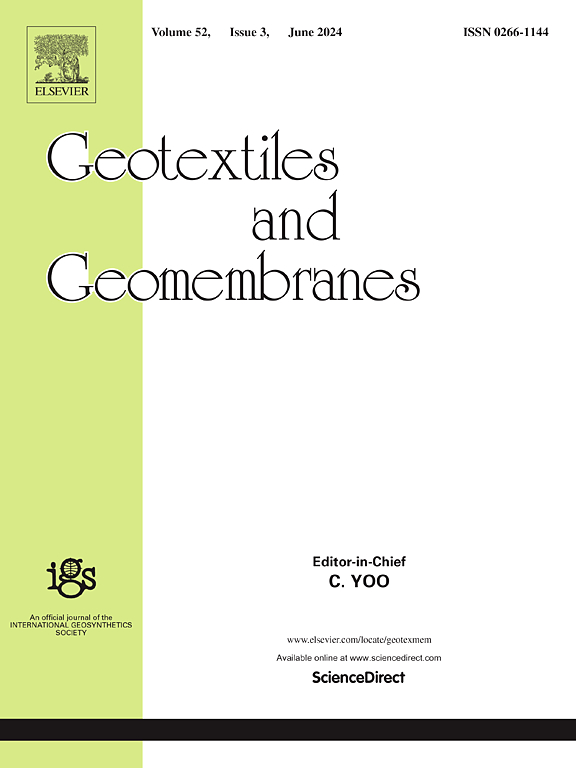Influence of rainfall and drying periods on the performance of a large-scale segmental GRS wall model built with poorly draining local soil
IF 6.2
1区 工程技术
Q1 ENGINEERING, GEOLOGICAL
引用次数: 0
Abstract
The use of poorly draining local soils as backfill material in geosynthetic reinforced soil walls has become a common practice despite the known risks. With climate change effects, it is crucial to understand how these structures will perform under such extreme conditions. In this study, the performance of a large-scale model of a modular block geogrid-reinforced soil wall, using fine-grained backfill material, is evaluated under varying simulated rainfall intensities and drying periods. The model was constructed in a laboratory environment, enabling the implementation of an extensive instrumentation program designed to monitor soil suction, volumetric water content, and the resulting deformation and reinforcement strains. Tensile loads mobilized by the geogrid within the backfill soil and at the connection with block wall facing are discussed in the paper. The study demonstrates the satisfactory performance of a poorly draining reinforced soil wall even after prolonged and intense simulated rainfall. The low hydraulic conductivity of the well-compacted backfill soil, combined with significant surface runoff, helped maintain low levels of soil suction which reflects in apparent cohesion. Drying periods led to varying but significant rates of suction recovery influenced by rainfall-drying patterns. The findings indicate that rainfall intensities of 10 mm/h (240 mm/day) for over 7 days were insufficient to fully eliminate suction in a poorly draining geogrid-reinforced wall.
降雨和干燥期对局部排水差的大尺度分段式GRS墙体模型性能的影响
使用排水差的当地土壤作为土工合成加筋土墙的回填材料已经成为一种常见的做法,尽管已知的风险。由于气候变化的影响,了解这些结构在这种极端条件下的表现是至关重要的。在这项研究中,采用细粒回填材料的模块化块格土工格栅加筋土墙的大尺度模型在不同的模拟降雨强度和干燥时间下的性能进行了评估。该模型是在实验室环境中构建的,可以实施广泛的仪器程序,用于监测土壤吸力、体积含水量以及由此产生的变形和加固应变。本文讨论了土工格栅在回填土内及与砌块墙接头处所调动的拉伸荷载。研究表明,在长时间的强模拟降雨作用下,疏水性较差的加筋土墙仍具有良好的性能。压实良好的回填土的低水力导率,加上大量的地表径流,有助于保持较低的土壤吸力水平,这反映在表观粘聚性上。干燥期导致受降雨干燥模式影响的吸力恢复速率变化但显著。研究结果表明,持续7天以上的10毫米/小时(240毫米/天)降雨强度不足以完全消除排水差的土工格栅加筋墙的吸力。
本文章由计算机程序翻译,如有差异,请以英文原文为准。
求助全文
约1分钟内获得全文
求助全文
来源期刊

Geotextiles and Geomembranes
地学-地球科学综合
CiteScore
9.50
自引率
21.20%
发文量
111
审稿时长
59 days
期刊介绍:
The range of products and their applications has expanded rapidly over the last decade with geotextiles and geomembranes being specified world wide. This rapid growth is paralleled by a virtual explosion of technology. Current reference books and even manufacturers' sponsored publications tend to date very quickly and the need for a vehicle to bring together and discuss the growing body of technology now available has become evident.
Geotextiles and Geomembranes fills this need and provides a forum for the dissemination of information amongst research workers, designers, users and manufacturers. By providing a growing fund of information the journal increases general awareness, prompts further research and assists in the establishment of international codes and regulations.
 求助内容:
求助内容: 应助结果提醒方式:
应助结果提醒方式:


